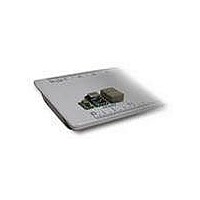RCR-433-HP3V Radiotronix, RCR-433-HP3V Datasheet - Page 4

RCR-433-HP3V
Manufacturer Part Number
RCR-433-HP3V
Description
RF Modules & Development Tools 433 MHz Receiver 3V
Manufacturer
Radiotronix
Datasheet
1.RCR-433-HP3V.pdf
(5 pages)
Specifications of RCR-433-HP3V
Lead Free Status / RoHS Status
Lead free / RoHS Compliant
RCR-XXX-HP Super-Het ASK/OOK Receiver
Pin Description
Pin
1
2
3
4
5
6
Theory of Operation
Super-Heterodyne AM Detection
The RCR-XXX-HP is a super-heterodyne AM receiver with a built-in data slicer. The incoming AM
carrier is amplified and downconverted to an intermediate frequency (IF) of 10.7MHz. This IF is
filtered using a ceramic bandpass filter with a 150kHz 3dB bandwidth.
The output of the IF filter is then amplified and demodulated using diode detector. The output of
the diode detector is the demodulated AM envelope of the carrier. This signal is applied to the
data slicer to generate the TTL/CMOS output.
Data Slicer
The data slicer converts the baseband analog signal from the diode detector to a CMOS/TTL
compatible output. Because the data slicer is AC coupled to the audio output, there is a minimum
data rate. AC coupling also limits the minimum and maximum pulse width. Typically, data is
encoded on the transmit side using pulse-width modulation (PWM) or non-return-to zero (NRZ).
The most common source for NRZ data is from a UART embedded in a micro-controller.
Applications that use NRZ data encoding typically involve microcontrollers. Refer to the RCR-
XXX-HP designer’s guide for more information on using NRZ data encoding.
The most common source for PWM data is from a remote control IC such as the HC-12E from
Holtek.
Data is sent as a constant rate square-wave. The duty cycle of that square wave will generally be
either 33% (a zero) or 66% (a one). The data slicer on the RCR-XXX-HP is optimized for use with
PWM encoded data, though it will work with NRZ data if certain encoding rules are followed. The
data slicer is designed to drive one(1) TTL or CMOS load. A buffer must be used if the data
output is going to drive more than one TTL/CMOS load or if the load is a lower-impedence
(<100K).
Power Supply
The RCR-XXX-HP is designed to operate from a 5V power supply. It is crucial that this power
supply be very quiet. The power supply should be bypassed using a 0.01uF low-ESR ceramic
capacitor and a 4.7µF tantalum capacitor. These capacitors should be placed as close to the
power pins as possible. The RCR-XXX-HP is designed for continuous duty operation. From the
time power is applied, it can take up to 100mSec for the data output to become
valid.
Name
GND
DATA
V
NC
ANT
GND
cc
(5v)
Description
Receiver Ground. Connect to ground plane.
Digital data output. This output is capable of driving one TTL or CMOS load. It is a
CMOS compatible output.
Provides operating voltage for the receiver. VCC should be bypassed with a
.01µF ceramic capacitor and filtered with a 4.7µF tantalum capacitor. Noise on the
power supply will degrade receiver sensitivity.
Do Not Connect.
50 Ω antenna input.
Receiver Ground. Connect to ground plane.
- 3 -
Data Sheet
5/19/2006












